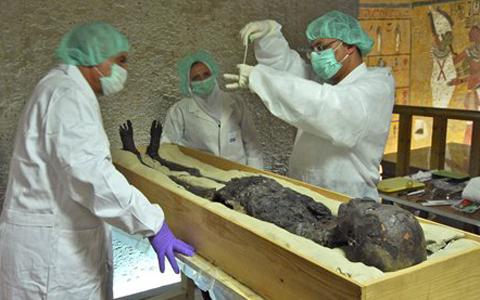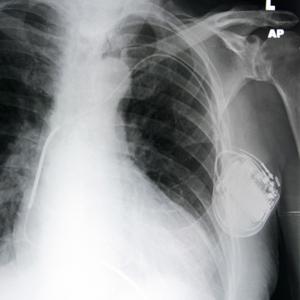
Scientists working on the mummy of King Tutankhamun in Luxor, Egypt
BOB DOUGHTY: This is SCIENCE IN THE NEWS in VOA Special English. I'm Bob Doughty.
FAITH LAPIDUS: And I'm Faith Lapidus. Today, we will tell how technology used in airports may help in the study of disease. We will tell about an idea for improving heart care in developing countries. We will also tell about a project that scientists hope will protect an endangered species of frogs.
(MUSIC)
BOB DOUGHTY: Scientists say technology used to search people in airports could help doctors understand how some diseases developed.
Frank Ruhli is head of the Swiss Mummy Project at the University of Zurich. Five years ago, he used computed tomography to study the remains of Tutankamun, the famous boy ruler of ancient Egypt. A computed tomography, or CT scan, provides detailed images of the inner body. Doctor Ruhli used CT scans to investigate the cause of King Tut's death.
Now, he says, technology used to search airline passengers for explosives can provide even more information. Radiation used in CT scans may be harmful to the genetic material within mummified remains. However, no radiation is involved with terahertz imaging, also known as full body scan technology.
Doctor Ruhli says scientists could better understand mummies if they used both CT scans and terahertz imaging technology. For example, he believes it may be possible to examine substances within a mummy, like embalming liquid.
FAITH LAPIDUS: Recently, Doctor Ruhli and his team studied ways they could use terahertz imaging to examine mummies. He says the images they gathered appear very promising.
The mummification process protects the body’s soft tissue long after it would normally break down. The tissue may contain evidence of the virus or bacteria that caused the person to die.
Frank Ruhli is both a medical doctor and a paleo-pathologist. He says the information lying within mummies is not just interesting for historians, but other people. He says looking back thousands of years can help researchers look forward by understanding how a disease changed over time.
BOB DOUGHTY: Researchers can produce a genetic map of a bacterium or virus. This way, they can observe changes in the structure of a deadly organism from one generation to the next.
Doctor Ruhli says researchers used this method to study changes in the tuberculosis bacteria from 2000-year-old mummified tissue. Scientists also completed similar research on victims of the Spanish flu epidemic in 1918. Frank Ruhli says studies like this can prove useful in the fight against H1N1, another form of the influenza virus.
Doctor Ruhli presented his case for the value of mummies for medical research at a meeting of the American Association of Anatomists. He says this kind of research could never replace modern medical studies. But he says taking a long-term look at diseases can help provide information scientists might otherwise miss.
(MUSIC)
FAITH LAPIDUS: A pacemaker is a small device that doctors place in people with an abnormal heartbeat. If a heart beats too slowly, the device will use electrical signals to help set a normal rate. Some pacemakers include a defibrillator, which gives a shock if the heart beats too fast.
Pacemakers may be permanent or temporary. But one thing is sure. Developing countries need more of them as more people get heart disease.

X-ray showing a pacemaker
A big problem, however, is cost. Buying and implanting a pacemaker costs from 5,000 to 15,000 dollars. Yet doctors at the University of Michigan think they know a way to lower that cost. The idea is to reuse pacemakers.
BOB DOUGHTY: Timir Baman is a heart doctor. He estimates that more than one million people worldwide need pacemakers each year. He says reusing a pacemaker is an ethical way to provide health care to those who have no other way to get one.
Doctor Baman got the idea a few years ago. One of his patients asked if someone might have her pacemaker for reuse after she died. However, are used pacemakers safe? Doctor Baman examined medical reports about the safety of used pacemakers in small studies. He says those studies showed no real difference when a used pacemaker was compared to a new one.
FAITH LAPIDUS: Funeral directors normally remove pacemakers when preparing bodies for cremation. Pacemakers can explode when burned. So Doctor Baman asked funeral directors in Michigan to send the pacemakers to him. He and other researchers at the University of Michigan Medical Center tested the used pacemakers. They cleaned and disinfected the ones in good working order. Then they sent them to doctors in the Philippines, Vietnam and Ghana.
The doctors successfully implanted the used pacemakers in 12 patients. The findings were presented at a conference of the American Heart Association.
Recently, Timir Baman asked the United States Food and Drug Administration for approval to do a larger test. He is hopeful the program will work. He would like other centers in the United States and Europe to form their own pacemaker reutilization programs. Such programs, he says, could really help many developing countries that need this kind of device.
(MUSIC)
BOB DOUGHTY: Finally, scientists say they have completed the first genetic map of an amphibian -- a western clawed frog. They also say the frog is one of the last invertebrates to have its genetic information identified. The scientists hope the work will protect endangered frog species. And, they say, the map may teach them about human disease.
Xenopus tropicalis is one of 20 frog species native to Africa, south of the Sahara. It lives almost all its life in water. One of its extended family members, Xenopus laevis, is often used in laboratory studies.
FAITH LAPIDUS: The word Xenopus means strange foot. There are about 20 different kinds of Xenopus frogs. Xenopus are very sensitive to a pregnancy hormone -- human chorionic gonadotropin. Scientists discovered the hormone last century. As a result, they used the frogs in fast-acting, low-cost pregnancy tests for women during the 1940s and 1950s.
Scientists also studied eggs from the frogs to learn about the development of fertilized eggs into embryos.
Tropicalis is among the smaller frogs in the Xenopus group. This is one of the reasons it was chosen for the genetic map, also called a genome. The researchers knew it would be easier and less costly to map a smaller frog with fewer chromosomal pairs.
BOB DOUGHTY: Scientists found the tropicalis genome contains more than 1.7 billion chemical bases along ten pairs of chromosomes. The frog has between 20,000 and 21,000 genes. Human beings have about 23,000. The researchers say that about 2,000 of tropicalis' genes are similar to human genes linked to cancer, asthma and heart disease.
Uffe Hellsten works with the Department of Energy Joint Genome Institute in Walnut Creek, California. It and the University of California, Berkeley, led the almost 50 scientists who helped with the frog genome project.
Mr. Hellsten says the genome of the Xenopus tropicalis opens up several paths of research. He says scientists can compare genes of the frog to those of other creatures with backbones, including humans.
UFFE HELLSTEN: “To mention an example, we have found that about 80 percent of all genes that are known to be associated with human disease have a counterpart in frogs. Obviously this opens up the possibility of enhancing our understanding of many of those diseases by studying disease models in frogs.”
FAITH LAPIDUS: Mr. Hellsten says to look at parts of the genome of Xenopus tropicalis is to look at structures 360 million years old. He says they are part of the genome of the last common ancestor of all birds, frogs, dinosaurs and mammals. He says research like the frog genome project helps humans understand the history of evolution. It shows how genetic material has re-organized itself to create the genomes of modern creatures. And, Mr. Hellsten says, genetic changes are rare for frogs, humans and most organisms.
A report about the study was published in Science magazine.
(MUSIC)
BOB DOUGHTY: This SCIENCE IN THE NEWS program was written by Caty Weaver and Brianna Blake. Our producer was June Simms. I'm Bob Doughty.
FAITH LAPIDUS: And I'm Faith Lapidus. Join us again next week for more news about science in Special English on the Voice of America.
tomography: X线体层照相术,X线断层照相术
terahertz: 太赫兹
paleo-pathologist: 古病理学家
pacemaker: an electronic device that is put inside a person's body to help their heart beat regularly 心脏起搏器; 心律调整器
amphibian: any animal that can live both on land and in water. Amphibians have cold blood and skin without scales. Frogs,toads and newts are all amphibians. 两栖动物
invertebrate: any animal with no backbone, for example a worm 无脊椎动物
chorionic gonadotropin: 绒毛膜促性腺激素
embryo: a young animal or plant in the very early stages of development before birth, or before coming out of its egg or seed, especially a human egg in the first eight weeks after fertilization 胚;胚胎;(尤指受孕后八周内的)人类胚胎
Reusing pacemakers could improve heart care in developing world
Back from the dead - 'extinct' frog found in Australian stream
How to get the most out of a workout
(来源:VOA 编辑:陈丹妮)
